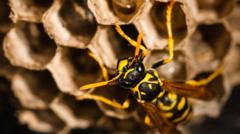A radioactive wasp nest has been found at the Savannah River Site (SRS) in South Carolina, previously a facility dedicated to manufacturing components for U.S. nuclear weapons. The U.S. Department of Energy (DOE) reported that the radiation levels detected in the nest were tenfold over the allowable safety regulations. The nest was treated to eliminate the wasps and subsequently categorized as radiological waste.
The significant radiation levels were identified during routine surveys conducted by site workers on July 3. The nest was located on a post in close proximity to large storage tanks containing millions of gallons of liquid nuclear waste. However, investigators have stated that there is no correlation between the nest's radiation and any leaks from these waste tanks.
The report attributes the high radiation readings to "onsite legacy radioactive contamination," referring to residual radioactivity left from the Cold War era operations when the site was engaged in plutonium production for nuclear arms. Despite the findings, the DOE reassured that the wasps inhabiting the nest would have had exposure to much lower radiation levels than the nest itself, as they typically stayed within a few hundred feet of their nest.
Environmental groups, including Savannah River Site Watch, are raising concerns over the handling of this situation, calling for more transparency regarding the origins of the radioactive contamination. Spokesperson Tom Clements expressed frustration over unanswered questions and the inadequate explanation surrounding potential leaks from waste tanks.
Even though the facility remains operational today, it has shifted its focus to supplying nuclear materials for power generation instead of weapons. The Savannah River Site has a historical footprint of producing over 165 million gallons of liquid nuclear waste, with 43 underground storage tanks still in service while eight have been decommissioned. The DOE's findings conclude that there are no immediate threats to workers, public safety, or the environment.


















